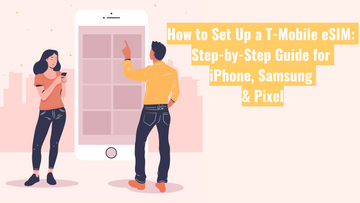Choosing the Right Travel SIM or eSIM for Your Trip

When you're preparing for a trip, staying connected is just as important as packing your passport. Choosing the right travel SIM or eSIM can make your journey smoother, helping you avoid expensive roaming fees and the stress of unreliable connections. Whether you’re heading off on a short holiday or a multi-country adventure, making the right choice early can save you time, money, and hassle later on.
What’s the Difference Between a SIM and an eSIM?
A SIM card is the small physical chip that connects your phone to a mobile network. An eSIM, on the other hand, is a digital version built into your device. Both allow you to connect to mobile networks abroad, but eSIMs are more convenient because they can be downloaded and activated without needing to insert a card.
So how do you know which one’s right for you? Here’s what to consider.
1. Understand Your Device
Before choosing a travel SIM or eSIM, check:
- Is your phone unlocked (able to use SIMs from other providers)?
- Does your phone support eSIM? (Not all models do.)
- Does your phone allow dual SIM use? This can let you keep your home number active while using data overseas.
Tip: If you’re unsure whether your device is eSIM-compatible, check your phone settings or visit our eSIM compatibility guide.
2. Consider Your Destination(s)
Where you’re going plays a big role in choosing the right travel SIM.
- Single-country SIMs/eSIMs are ideal if you’ll be staying in one place.
- Regional or global options are better for multi-country trips.
For example, if you’re travelling around Europe, a Europe travel eSIM will offer better value and coverage across multiple countries than buying a SIM for each one.
3. Estimate Your Data Needs
How much data you need depends on how you use your phone:
- Light users: use maps, messaging apps like WhatsApp, or check email
- Moderate users: browse social media, look up travel info
- Heavy users: stream video, upload large files, or hotspot to other devices
To put it in perspective: 10GB can last a light user a month, but a heavy user may go through that in a week.
4. Plan for Trip Duration & Flexibility
Are you travelling for a few days, several weeks, or longer? Choose a plan that suits:
- Some eSIMs last for 7, 15, or 30 days
- Others offer top-up or extension options
- If you’re unsure about your return date, choose a provider with flexible extensions
5. Compare Providers Carefully
Not all travel SIM or eSIM providers offer the same experience. When comparing:
- Look at coverage maps and supported countries
- Check if customer support is responsive and helpful
- Does the provider offer step-by-step activation support?
- Are there clear refund or troubleshooting policies?
6. Local SIM vs. Travel SIM
While buying a local SIM at your destination might sound cheaper, it can come with delays, language barriers, or compatibility issues. Pre-purchasing a travel SIM or eSIM ensures:
- Instant connection when you land
- No need to hunt for a store after a long flight
- Peace of mind that your phone will work overseas
7. Final Checklist Before You Buy
- ✅ Make sure your phone is unlocked and compatible
- ✅ Know which countries your SIM/eSIM will cover
- ✅ Choose a plan that suits your travel style and data needs
- ✅ Check reviews from other travellers about network quality and support
Stay Connected, Wherever You Go
Choosing the right travel SIM or eSIM can make a huge difference to your travel experience. Whether you’re exploring a new city or working remotely abroad, a reliable connection lets you focus on what really matters — enjoying the journey.
Explore Global Starlink’s range of flexible and affordable travel SIMs and eSIMs today, and make sure you’re connected the smart way, wherever your trip takes you.












